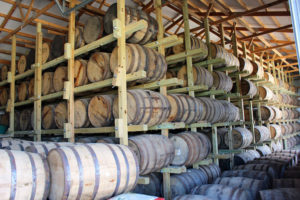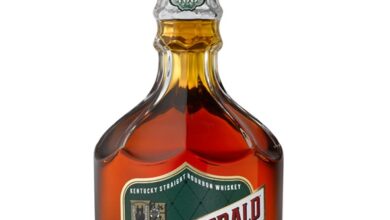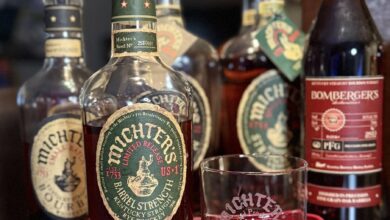Iowa Whiskey: Making Bourbon In Corn Country
There Is Much More To Whiskey-Making In Iowa Than Just Rye
By Richard Thomas

(Credit: Richard Thomas)
One of the peculiar features of the craft whiskey picture in the Hawkeye State is just how big a presence rye has in it. This is because of Templeton Rye, the notorious bottler that preceded the emergence of Iowa’s first micro-distilleries by several years. Templeton sourced their whiskey from MGP in Indiana’s 95% rye stock, while marketing it as derived from a Prohibition era rye-based moonshine recipe. The paradoxical outcome of Templeton’s prominence is that a place iconic in Americana for its corn production became identified in whiskey terms with rye!
Mind you, most of the corn grown in Iowa is for agro-industrial purposes, of the type a fuel distiller rather than a liquor distillery would want to use. Even so, corn is so synonymous with Iowa that you should abandon your notions of the state’s craft whiskey scene being dominated by rye. The rye is there alright, but it takes second place to bourbon and corn whiskey.
Iowa’s Big Crafties
Mississippi River Distilling Company: Sharing the riverfront town of LeClaire, Iowa with the American Pickers guys is one of the “Four Kings” of craft whiskey in the Mid-West, Mississippi River Distilling Company (MRDC). This micro-distillery enjoys a prominent spot not just in Iowa whiskey-making, but in the national craft distilling scene. Maker’s of Cody Road Bourbon and Cody Road Rye, they also produce single barrels and a variety of one-shot experimental whiskeys and seasonal liqueurs. This is on top of their role in the annual Four Kings collaboration whiskey project with Journeyman Distillery, FEW Spirits and Corsair Artisan Distillery.

(Credit: Richard Thomas)
Cedar Ridge Distillery: The American Distilling Institute’s 2017 Distillery of the Year, Cedar Ridge is also the oldest and currently the largest distillery in the state. They also have what is by far the widest whiskey line-up in Iowa. The present roster includes a bourbon, a five year old reserve bourbon, a malt whiskey and a single barrel malt whiskey, a wheat whiskey and a malted rye. Even with that expansive whiskey line, Cedar Ridge isn’t done yet and has even more whiskeys in development behind those!
Hawkeye Craft Whiskeys You Probably Don’t Know About, But Should
3-Oaks Distillery: This family-owned and -operated nano-distillery in northeastern Iowa has a single expression out, 3-Oaks Whiskey. That product is a four-grain (corn, rye, barley and malted barley) American whiskey.
Artisan Grain Distillery: This outfit set up shop in the middle of Davenport, one of the largest constituents of the Quad Cities. In addition to some rum releases, they have a corn-based moonshine.
Broadbent Distillery: Broadbent bills itself as “the smallest legal distillery in Iowa,” and is located due south of Des Moines. Their foundation product is their Two Jays Iowa Corn Whiskey, a 100% corn, unaged whiskey. They have slightly aged (Two Jays Country Style) and flavored releases spun out of that base.

(Credit: Richard Thomas)
The distillery also recently released Two Jays Urban Style, which is a light whiskey. The latter is a category many are not familiar with: light whiskey is distilled to a much higher strength than most American whiskeys, to between 80 and 95% alcohol, and then aged in either used or uncharred new barrels.
Iowa Distilling Company: This outfit in south-central Iowa is a good example of a “craft whiskey 2.0” style micro-distillery. While following the time-tested route of making a range of products, including a 100% corn whiskey, they also have a straight bourbon made with a high rye mash bill and aged in full-size, 53-gallon ASBs.
Legendary Rye: If you’re looking for an alternative to Templeton Rye, then look no further than Legendary Rye. Located in the same county as Templeton, these folks started by making their own in-house, 100% rye in their nano-distillery.
What’s Up With Templeton Rye?

(Credit: Templeton Rye)
Although Templeton, the biggest whiskey brand in the state, doesn’t have a working commercial distillery as of yet, they broke ground on one this past April. The new $26 million, 20-acre Templeton plant is expected to be operational by Fall 2018, and is anticipated to have a production capacity of 500,000 proof gallons annually. On top of that, the facility will also include warehousing for up to 40,000 barrels. That would place the new distillery well outside the realm of craft distilling and in the growing category of mid-sized operators, such as the recently opened Southern Distillery Company in North Carolina and Bardstown Bourbon Company in Kentucky.
The new plant will jump Templeton Rye from bottling company straight to medium-sized distiller, skipping the micro/craft status altogether. That only makes sense when you consider the need to at least support Templeton’s existing sales, to say nothing of expanding on them, coupled to the increased and rising demand for their supplier’s (Indiana’s MGP) products. Smaller brands than Templeton saw the writing on the wall starting as far back as a few years ago and made the switch, so it was inevitable that Templeton would too, and in so doing position themselves as the state’s biggest whiskey-maker.




